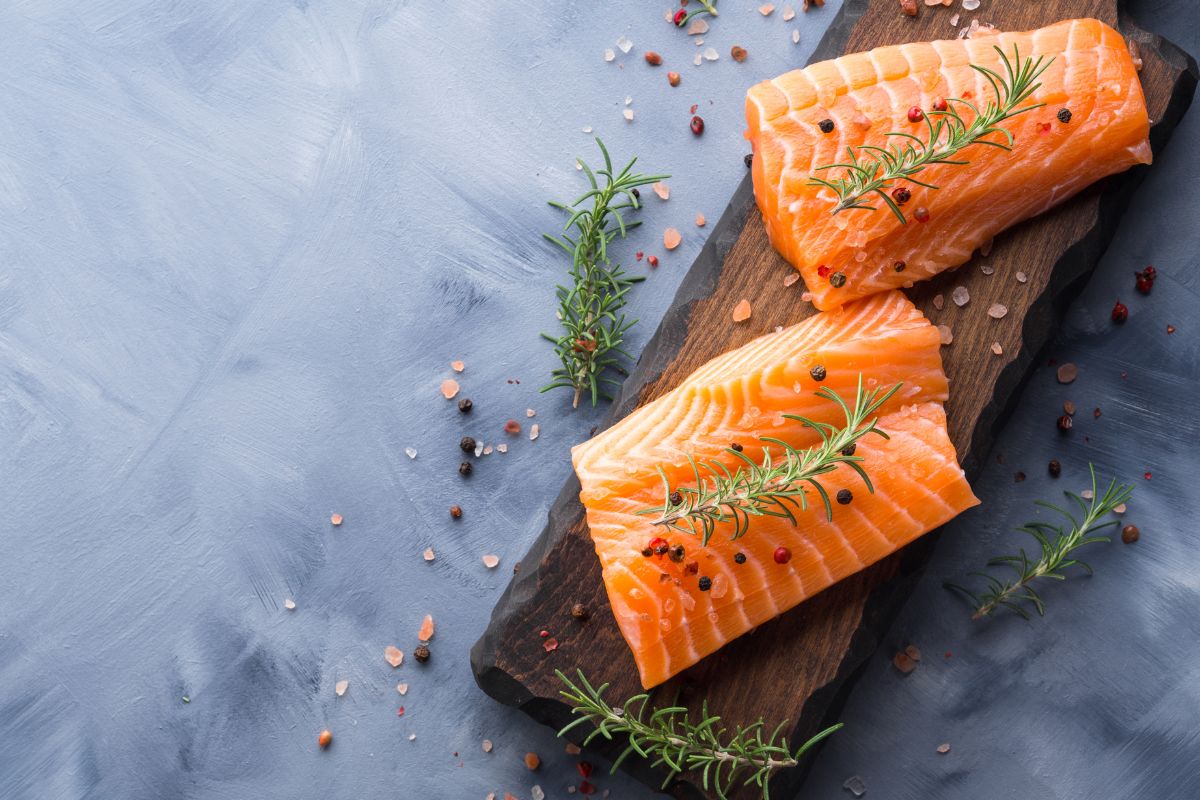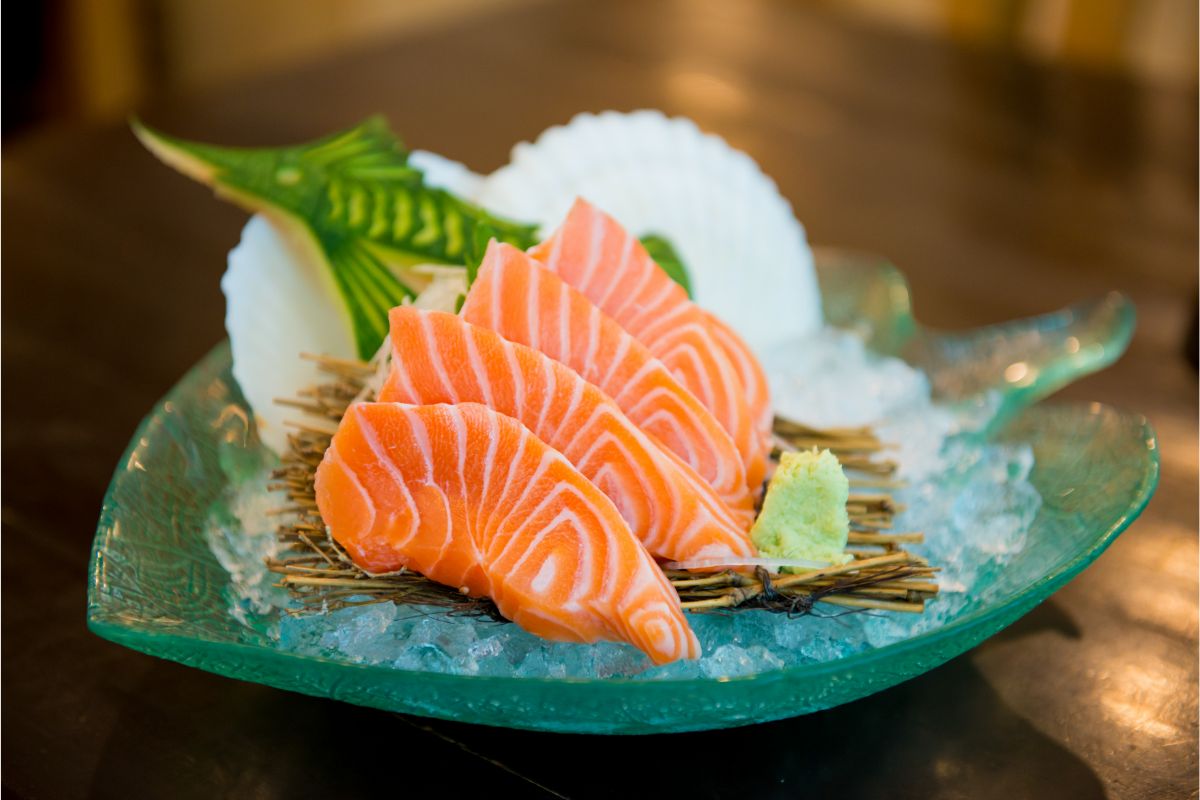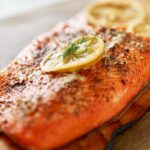Salmon is a delicious option that many people enjoy, however, I think that many individuals will often deny themselves of the stuff simply because they aren’t certain how to handle, store, prepare, or cook it.
And it can be a little tricky to get your head around.

It’s often baked, pan-fried, and grilled, and sometimes it’s even eaten raw. And it’s probably this fact, that it can be eaten uncooked, that trips so many people up.
Surely, if it can be eaten when it hasn’t been cooked at all, then a slightly undercooked salmon won’t hurt you, right?
Wrong. When salmon is stored, handled, prepared, or cooked incorrectly it can actually give you a pretty nasty bout of food poisoning. And nobody wants that.
You see, once your salmon gets to a certain temperature (around 40 degrees Fahrenheit) it becomes the perfect breeding ground for nasty bacteria and parasites. And trust me, you don’t want to consume them.
So, if you want to learn a little bit more about undercooked salmon…keep reading!
Is It Okay To Eat Slightly Undercooked Salmon?
Short Answer – NO
Okay, so there are quite a few different rules when it comes to salmon. Cold and raw salmon that’s been frozen for a minimum of seven days before – fine.
Cooked salmon that has reached the correct internal temperature – fine. Slightly undercooked salmon? – not fine at all.
As mentioned above, the reason for this is bacteria and parasites. You see, when the salmon is cold and raw it is too cold for the bacteria to breed.
When salmon is fully cooked, it’s too hot for bacteria to survive. When you’re in that slightly undercooked area – the bacteria is alive and thriving.
In temperatures of around 40 degrees to 140 degrees Fahrenheit, bacteria is able to breed, survive, and thrive. So if you eat salmon at this temperature, it’s likely that you’ll consume all that bacteria and it’ll make you pretty ill.
For example, eating undercooked salmon can cause risks such as salmonellosis, food poisoning, and several other nasty illnesses or health risks.
Therefore, it is vital to always check that your salmon has reached a minimum of 145 degrees Fahrenheit before consuming.
I’d also always advise to only ever order salmon from clean and safe restaurants.
How Likely Is It That You’ll Get Sick From Undercooked Salmon?
Short Answer – Very Likely
Undercooked salmon poses quite a high risk of getting sick. There’s a very good chance that you’ll contract food poisoning or a similar food-borne illness after consuming undercooked salmon.
And not only that, there are also risks of severe wound infection, sepsis, and gastrointestinal disease from eating the fish when undercooked, though these risks are less likely.
The reason for this is that there are just so many different types of bacteria and parasites that can thrive in undercooked salmon such as:
- Shigella
- Norovirus
- Vibrio Vulnificus
- Cod worms
- Hepatitis A
- Staphylococcus aureus
Now, don’t let this put you off from eating salmon altogether. When salmon is cooked right, you’ll rarely develop any issues.
In fact, there are on average less than 10 cases of cooked-salmon-related illnesses every year. It’s only when it’s undercooked that you really start to have a problem.
This is also why freezing your fish before consuming raw is always advised – it helps to kill off most of the nasty stuff lurking in your fish.
And when it comes to food-borne illnesses, most people will tend to have a speedy recovery as long as they get plenty of rest and fluids.
With this being said though, there are some individuals that will be more vulnerable to an infection such as:
- The elderly
- Children
- Young infants
- People with compromised immune systems
- Pregnant women
Any individual should always contact a medical professional in the case of an infection, but this is especially the case for those who are more vulnerable.

How To Know If Your Salmon Is Fully Cooked?
Short Answer – It reaches 145 Degrees F
The best way to know if your salmon is cooked is to take an internal temperature reading. If it’s above 145 degrees Fahrenheit, then you’re good to go.
Typically, a 6 oz salmon should take anywhere between 11-14 minutes in a 400-degree Fahrenheit oven.
Also, the salmon should never have an overwhelming fishy odor before or after it’s placed in the oven – if it does it’s probably best not to risk it.
You can also test your salmon once it’s finished in the oven. When cooked it should easily flake away when you spear it with a fork or knife.
When salmon is difficult to cut or tear apart, this is usually a good indicator that it isn’t fully cooked.
You can also look to see if your salmon is emitting a white substance known as Albumin. This happens when the salmon is good to go.
If there is an excess of Albumin, however, this usually means that the salmon is overcooked.
How Long Does Salmon Take To Cook
Short Answer – Between 10-20 minutes depending on the cooking method.
How long your salmon takes to cook will depend entirely on the method of cooking you choose.
Regardless of which option you choose though, it will usually never take longer than around 20 minutes – it’s a pretty fast-cooking meat option.
Based on a 6 oz salmon, you can expect it to take between 11-14 minutes in the oven, around 10-15 minutes when pan-fried, and around 10-20 minutes when it has been grilled.
Really though, you shouldn’t base whether your salmon is cooked on minutes cooked because it can vary so much. For example, a larger piece of salmon is going to take a lot longer to cook than a smaller one.
What you should really be paying close attention to is that internal temperature. As long as you hit that sweet spot of 145 degrees Fahrenheit, you can always have peace of mind that your salmon is cooked correctly.
Frequently Asked Questions
No one wants to eat parasites, let’s be honest. So knowing what they look like is important. The most common parasite found in salmon is cod worms.
These are little small squiggly worms. They can typically be spotted quite quickly in salmon due to the pink hue of the fish.
Luckily, the chances of actually finding these little worms are pretty uncommon and as long as the fish is cooked correctly they’ll be killed in the cooking process anyway.
When cooking salmon, it can sometimes be a little off-putting to see a white substance oozing from the fish. Don’t worry, though, this is Albumin, a water-soluble form of protein that is produced by heat.
This isn’t bad for you and is actually a good indicator to let you know that your salmon is cooked. Beware, though, too much of it means that the fish is overcooked.
Unexpected changes in color can always instill fear into us while cooking. But for the most part, this usually isn’t a cause for concern.
This is usually because the salmon you have eaten has been raised and farmed and so has not had access to natural carotenoids found in a salmon’s typical diet of shrimp and kill that gives it it’s coloring.
However, occasionally this can be a sign that the salmon has gone rancid so you should always be cautious with white salmon.
Final Thoughts
So, hopefully from this article you have learned that while raw salmon or cooked salmon is good to go, undercooked salmon is a disaster waiting to happen that should be avoided at all costs.
It is a great practice to always check the internal temperature of your salmon to ensure that it has reached 145 degrees Fahrenheit. This way you know that it will not make you sick.
If you are ever unsure as to whether or not your salmon is cooked, it’s best not to risk it, especially considering the plethora of parasites and bacteria that are just desperate to breed on undercooked salmon.
- How To Reheat A Cheesesteak - November 5, 2023
- What Are Three Must Have Kitchen Knives? - September 22, 2023
- How To Protect Edges Of Pie Crust - June 15, 2023








